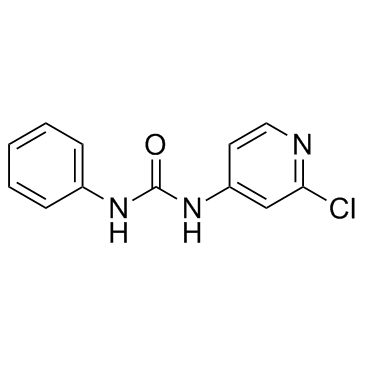68157-60-8
| Name | forchlorfenuron |
|---|---|
| Synonyms |
N-(2-chloropyridin-4-yl)-N’-phenylurea
KT-30 N-(2-chloro-4-pyridinyl)-N’-phenylurea 4pu30 CN-11-3183 CPPU fulmet 1-(2-Chloro-4-Pyridyl)-3-Phenylurea MFCD00059898 SITOFEX v3183 cn11-3138 4-CPPU |
| Description | Forchlorfenuron is plant growth regulator and cytokinin; can be used to increase fruit size of fruits, such as kiwi fruit and grapes. |
|---|---|
| Related Catalog | |
| In Vitro | Forchlorfenuron is a plant growth regulator, applied extensively to increase kiwifruit size and weight. Cytotoxicity of forchlorfenuron and its metabolites are tested through Sulforhodamine B assays against CHO cells. Forchlorfenuron exhibits significant cytotoxicity against CHO cells with an IC50 of 12.12±2.14 μM[1]. The half-lives offorchlorfenuron were 15.8-23.0 days, the final residues of forchlorfenuron in pulp were all ≤0.002 mg/kg, and most of the residues were concentrated in the peel. The risk assessment revealed that no significant potential health risk would be induced by forchlorfenuron in citrus fruits. Therefore, it could be safe to apply forchlorfenuron in citrus fruits[2]. |
| Cell Assay | CHO cells are cultured in high-glucose DMEM medium. Forchlorfenuron and its kiwifruit metabolites are dissolved in DMSO and diluted in culture media. Cells are seeded in a 96-well flat microtiter plate for 24 h and are then incubated for an additional 48 h with various concentrations of the compounds. Next, cells are fixed with 10% trichloroacetic acid and incubated for 60 min at 4 °C. The supernatant is discarded, then the plates are washed. Using 0.4% SRB solution dissolved in 1% acetic acid, the cell layer is strained, then the plates are incubated for 20 min at room temperature. The stained cells is solubilized in 10 mM un-buffered Tris base and optical density (OD) is measured at 560 nm[1]. |
| References |
| Density | 1.3±0.1 g/cm3 |
|---|---|
| Boiling Point | 426.5±55.0 °C at 760 mmHg |
| Melting Point | 170-172°C |
| Molecular Formula | C12H10ClN3O |
| Molecular Weight | 247.680 |
| Flash Point | 211.7±31.5 °C |
| Exact Mass | 247.051239 |
| PSA | 54.02000 |
| LogP | 3.83 |
| Vapour Pressure | 0.0±1.1 mmHg at 25°C |
| Index of Refraction | 1.629 |
| Storage condition | 2-8°C |
| Symbol |


GHS08, GHS09 |
|---|---|
| Signal Word | Warning |
| Hazard Statements | H351-H411 |
| Precautionary Statements | P273-P281 |
| Personal Protective Equipment | dust mask type N95 (US);Eyeshields;Gloves |
| Hazard Codes | Xi: Irritant; |
| Risk Phrases | R36/37 |
| Safety Phrases | S26-S36 |
| RIDADR | UN3077 9/PG 3 |
| WGK Germany | 3 |
| RTECS | YS7182500 |
| HS Code | 2933399090 |
| HS Code | 2933399090 |
|---|---|
| Summary | 2933399090. other compounds containing an unfused pyridine ring (whether or not hydrogenated) in the structure. VAT:17.0%. Tax rebate rate:13.0%. . MFN tariff:6.5%. General tariff:20.0% |


